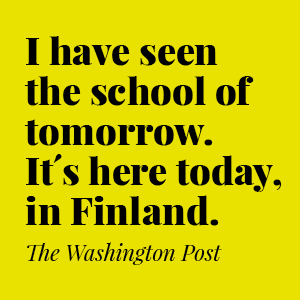World’s Best National Curriculum
Why to reform a well-functioning system?
“Content of teaching, pedagogy and school practices should be reviewed and renewed in relation to the changes in the operating environment.” (Finland’s National Board of Education)
We have a new national core curriculum in Finland! Schools started to use the renewed curriculum in August this year for grades 1-6. Many people have asked why Finland is changing the curriculum. Finland’s previous curriculum brought us excellent learning outcomes and results in international comparison (e.g. in OECD’s Pisa tests). Why change something that is obviously working so well?
There are at least two main reasons for that. For the first thing, the world has changed tremendously since our previous curriculum was released in 2004: the impact of globalization and the challenges for sustainable future, new information and novel innovations, new problems and crisis etc. What bought us excellent learning results in the past isn’t necessarily meeting the needs and challenges of the future.
“Education both builds our future and addresses future challenges.”
In Finland we have never educated our children in order them to gain outstanding results in international comparisons. The ultimate goal for Finnish education has been for years to prepare our children for life. We want our children to learn the knowledge, skills, attitudes and values that will help in their life in the future. That’s why we need to think, what are the key competencies they will need in the changing world? What are the required skills for building a sustainable future? And what kind of practices would best produce the desired education and learning?
So what do we see as most important in basic education right now? What have been the guiding principles in outlining the new national core curriculum? The answer is this:
- Sustainable future as an objective
- Equality in all areas of education
- Meeting pupils’ needs and supporting wellbeing and other prerequisites for learning
- Building on strengths
- Coherence and consistency of basic education, learning continuums
- International aspects and global responsibility
- Awareness of languages and cultures, regarding them as richness
- Technological change, working with knowledge
- Challenges for broad-based, multimodal literacy
(Finland’s National Board of Education)
The ultimate goal in the curriculum reform has been more participatory, physically active, creative and linguistically enriched schools and integrated teaching and learning.
The second reason for renewing the curriculum: we don’t think that our education system – yet along curriculum – is perfect. It is a very Finnish mindset to try to constantly improve something. If you ask Finns whether they are happy with their world-class education, the answer will likely be “Yes, but…”. We always see that we could improve things even further. That’s why we don’t think we should sit still with our curriculum as well.
In Finland every school year starts with teacher-parents meetings. Usually teacher tells about current issues at schools and matters are discussed together with parents. This autumn I’ve attended three such meetings as a mother. In those meetings there has been one topic above everything else: the new curriculum. The teachers have told about the goals and principles of the new curriculum and parents have discussed about them actively. Parents strongly support the idea behind the new curriculum: to give our children the knowledge and skills they will need in the future.
And I must say, I’m excited about the new curriculum! It brings new elements to the high-quality Finnish education and strengthens some of the existing ones. The activating teaching and learning methods, collaboration, the phenomenon-based learning, strong integration between school subjects, new assessment culture and practices, diverse learning environments, strengthening of citizen skills, life-long learning, enhancing social skills and good manners, defining broad-based competence across subject groups etc. are all excellent additions to the high-quality Finnish basic education. If you want to know more, all these topics will also be covered in Teacher Academy Finland program.
“Change requires strong leadership and a great deal of shared thinking.”
This new curriculum is research-based and has been carefully planned for over a decade. The teachers themselves have had a key role in designing the new curriculum and everyone interested had the chance to take part in the public discussion over it (we had webpages where anyone had the opportunity to comment the curriculum when it was still under process). It has been what we call “Partnership-based and transparent planning process”. I think it is this careful and interactive planning process that has brought us a broad consensus over the new curriculum. (If you are interested in the Curriculum reform process in Finland, you can read more here.)
When the World’s best education system takes the next step to the future where does that take us? The years to come will tell. I strongly believe the answer is this: we have the best national curriculum in the World!
Yours sincerely,
Johanna

